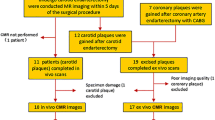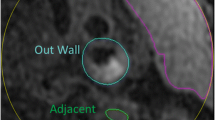Abstract
Objectives
This study sought to validate the performance of simultaneous non-contrast angiography and intraplaque hemorrhage (SNAP) imaging in characterizing carotid IPH by histology.
Methods
Thirty-five patients with carotid atherosclerotic disease (symptomatic 50–70% stenosis or > 70% stenosis) scheduled for carotid endarterectomy underwent 3.0-T carotid MR imaging by acquiring SNAP and magnetization-prepared rapid acquisition gradient-echo (MP-RAGE) sequences. Presence and area of IPH were separately evaluated on SNAP and MP-RAGE images. Presence and area of IPH were also assessed on histology. Agreement between SNAP/MP-RAGE and histology was determined in identify and quantify IPH using Cohen kappa, Spearman correlation, and Bland-Altman analyses.
Results
Of all 35 patients (mean age: 63.1 ± 8.8 years; 27 males), 128 slices with successful registration were eligible for analysis. The accuracy, sensitivity, specificity, and positive and negative predictive values were 86.7%, 85%, 89.6%, 93.2%, and 78.2% for SNAP, and 76.6%, 75%, 79.2%, 85.7%, and 65.5% for MP-RAGE in identification of IPH, respectively. In identification of IPH, the kappa value between SNAP and histology and between MP-RAGE and histology was 0.725 and 0.520, respectively. The correlation between SNAP and histology (r = 0.805, p < 0.001) was stronger than that between MP-RAGE and histology (r = 0.637, p < 0.001) in measuring IPH area. Bland-Altman analysis showed that, in measuring IPH area, the bias of SNAP (1.4 mm2, 95% CI: − 0.016 to 2.883) was smaller than that of MP-RAGE (1.7 mm2, 95% CI: − 0.039 to 3.430) compared with histology.
Conclusions
This validation study by histology demonstrates that SNAP sequence better identifies and quantifies carotid intraplaque hemorrhage compared with traditional MP-RAGE sequence.
Key Points
• SNAP imaging showed better agreement with histology compared with MP-RAGE imaging, especially for the IPHs with small size.
• SNAP sequence is a more effective tool to identify and quantify carotid IPH than traditional sequence of MP-RAGE that can help clinicians to optimizing the treatment strategy.
• The plaque components of rich lipid pools or loose matrix and chronic/old IPH (cholesterol crystals) can lead to false positive and false negative results in SNAP and MP-RAGE imaging for identifying IPH.






Similar content being viewed by others
Abbreviations
- CEA:
-
Carotid endarterectomy
- IPH:
-
Intraplaque hemorrhage
- MP-RAGE:
-
Magnetization-prepared rapid acquisition gradient-echo
- PSIR:
-
Phase-sensitive inversion-recovery reconstruction
- SNAP:
-
Simultaneous non-contrast angiography and intraplaque hemorrhage
References
Michel JB, Virmani R, Arbustini E, Pasterkamp G (2011) Intraplaque haemorrhages as the trigger of plaque vulnerability. Eur Heart J 32:1977–1985
Takaya N, Yuan C, Chu B et al (2005) Presence of intraplaque hemorrhage stimulates progression of carotid atherosclerotic plaques: a high-resolution magnetic resonance imaging study. Circulation 111:2768–2775
Saam T, Cai J, Ma L et al (2006) Comparison of symptomatic and asymptomatic atherosclerotic carotid plaque features with in vivo MR imaging. Radiology 240:464–472
Altaf N, MacSweeney ST, Gladman J, Auer DP (2007) Carotid intraplaque hemorrhage predicts recurrent symptoms in patients with high-grade carotid stenosis. Stroke 38:1633–1635
Saam T, Hetterich H, Hoffmann V et al (2013) Meta-analysis and systematic review of the predictive value of carotid plaque hemorrhage on cerebrovascular events by magnetic resonance imaging. J Am Coll Cardiol 62:1081–1091
Gupta A, Baradaran H, Schweitzer AD et al (2013) Carotid plaque MRI and stroke risk: a systematic review and meta-analysis. Stroke 44:3071–3077
Sun J, Underhill HR, Hippe DS, Xue Y, Yuan C, Hatsukami TS (2012) Sustained acceleration in carotid atherosclerotic plaque progression with intraplaque hemorrhage: a long-term time course study. JACC Cardiovasc Imaging 5:798–804
Kampschulte A, Ferguson MS, Kerwin WS et al (2004) Differentiation of intraplaque versus juxtaluminal hemorrhage/thrombus in advanced human carotid atherosclerotic lesions by in vivo magnetic resonance imaging. Circulation 110:3239–3244
Hosseini AA, Kandiyil N, Macsweeney ST, Altaf N, Auer DP (2013) Carotid plaque hemorrhage on magnetic resonance imaging strongly predicts recurrent ischemia and stroke. Ann Neurol 73:774–784
Yamada K, Yoshimura S, Kawasaki M et al (2011) Embolic complications after carotid artery stenting or carotid endarterectomy are associated with tissue characteristics of carotid plaques evaluated by magnetic resonance imaging. Atherosclerosis 215:399–404
Wang X, Sun J, Zhao X et al (2017) Ipsilateral plaques display higher T1 signals than contralateral plaques in recently symptomatic patients with bilateral carotid intraplaque hemorrhage. Atherosclerosis 257:78–85
Ota H, Yarnykh VL, Ferguson MS et al (2010) Carotid intraplaque hemorrhage imaging at 3.0-T MR imaging: comparison of the diagnostic performance of three T1-weighted sequences. Radiology 254:551–563
Wang J, Bornert P, Zhao H et al (2013) Simultaneous noncontrast angiography and intraplaque hemorrhage (SNAP) imaging for carotid atherosclerotic disease evaluation. Magn Reson Med 69:337–345
Li D, Zhao H, Chen X et al (2018) Identification of intraplaque haemorrhage in carotid artery by simultaneous non-contrast angiography and intraplaque haemorrhage (SNAP) imaging: a magnetic resonance vessel wall imaging study. Eur Radiol 28:1681–1686
Lusby RJ, Ferrell LD, Ehrenfeld WK, Stoney RJ, Wylie EJ (1982) Carotid plaque hemorrhage. its role in production of cerebral ischemia. Arch Surg 117:1479–1488
Yuan C, Mitsumori LM, Ferguson MS et al (2001) In vivo accuracy of multispectral magnetic resonance imaging for identifying lipid-rich necrotic cores and intraplaque hemorrhage in advanced human carotid plaques. Circulation 104:2051–2056
Schneider CA, Rasband WS, Eliceiri KW (2012) NIH Image to ImageJ: 25 years of image analysis. Nat Methods 9:671–675
Liu J, Balu N, Hippe DS et al (2016) Semi-automatic carotid intraplaque hemorrhage detection and quantification on magnetization-prepared rapid acquisition gradient-echo (MP-RAGE) with optimized threshold selection. J Cardiovasc Magn Reson 18:41
Underhill HR, Yuan C, Terry JG et al (2008) Differences in carotid arterial morphology and composition between individuals with and without obstructive coronary artery disease: a cardiovascular magnetic resonance study. J Cardiovasc Magn Reson 10:1–11
Virmani R, Kolodgie FD, Burke AP, Farb A, Schwartz SM (2000) Lesions from sudden coronary death: a comprehensive morphological classification scheme for atherosclerotic lesions. Arterioscler Thromb Vasc Biol 20:1262–1275
Wang J, Ferguson MS, Balu N et al (2010) Improved carotid intraplaque hemorrhage imaging using a slab-selective phase-sensitive inversion-recovery (SPI) sequence. Magn Reson Med 64:1332–1340
Dai Y, Lv P, Lin J et al (2017) Comparison study between multicontrast atherosclerosis characterization (MATCH) and conventional multicontrast MRI of carotid plaque with histology validation. J Magn Reson Imaging 45:764–770
Fan Z, Yu W, Xie Y et al (2014) Multi-contrast atherosclerosis characterization (MATCH) of carotid plaque with a single 5-min scan: technical development and clinical feasibility. J Cardiovasc Magn Reson 16:53
Chu B, Kampschulte A, Ferguson MS et al (2004) Hemorrhage in the atherosclerotic carotid plaque: a high-resolution MRI study. Stroke 35:1079–1084
Liu J, Sun J, Balu N et al (2019) Semiautomatic carotid intraplaque hemorrhage volume measurement using 3D carotid MRI. J Magn Reson Imaging 50:1055–1062
Funding
This study is supported by grants of Ministry of Science and Technology of China (2017YFC1307904), National Natural Science Foundation of China (81771825, U1801681), and Beijing Municipal Science and Technology Commission (D171100003017003), the Key Areas Research and Development Program of Guangdong (2019B020235001), Guangdong Province Universities, and Colleges Pearl River Scholar Funded Scheme (2017).
Author information
Authors and Affiliations
Corresponding authors
Ethics declarations
Guarantor
The scientific guarantor of this publication is Xihai Zhao.
Conflict of interest
The authors of this manuscript declare no relationships with any companies whose products or services may be related to the subject matter of the article.
Statistics and biometry
No complex statistical methods were necessary for this paper.
Informed consent
Written informed consent was obtained from all subjects (patients) in this study.
Ethical approval
Institutional Review Board approval was obtained.
Methodology
• retrospective
• observational
• multicenter study
Additional information
Publisher’s note
Springer Nature remains neutral with regard to jurisdictional claims in published maps and institutional affiliations.
Rights and permissions
About this article
Cite this article
Li, D., Qiao, H., Han, Y. et al. Histological validation of simultaneous non-contrast angiography and intraplaque hemorrhage imaging (SNAP) for characterizing carotid intraplaque hemorrhage. Eur Radiol 31, 3106–3115 (2021). https://doi.org/10.1007/s00330-020-07352-0
Received:
Revised:
Accepted:
Published:
Issue Date:
DOI: https://doi.org/10.1007/s00330-020-07352-0




